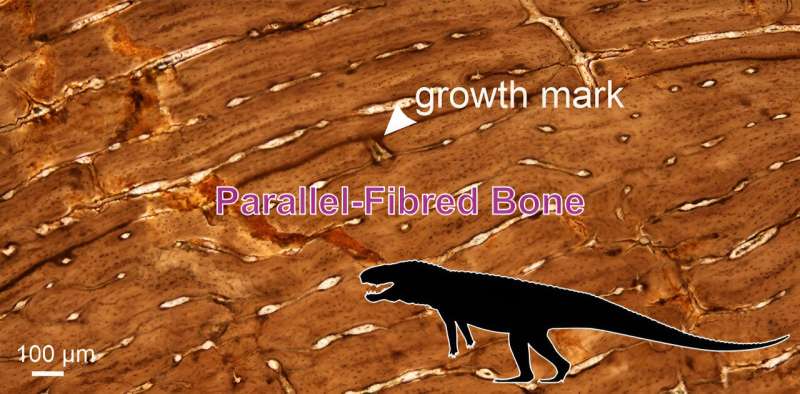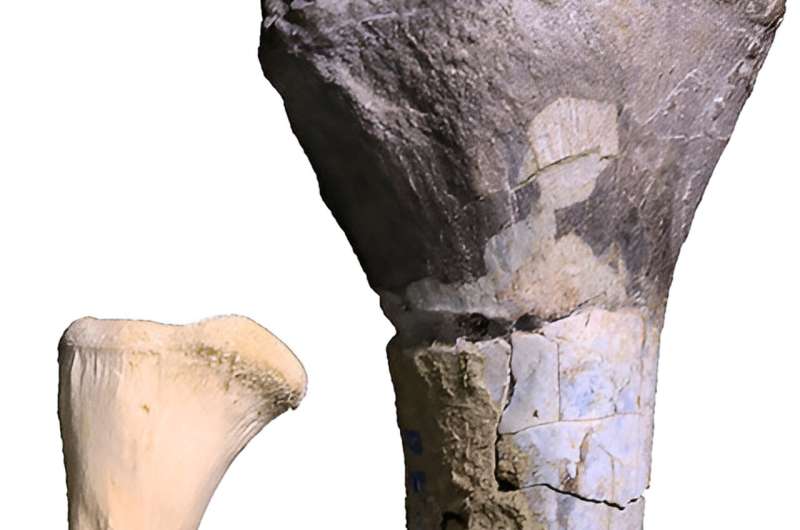This article has been reviewed according to Science X's editorial process and policies. Editors have highlighted the following attributes while ensuring the content's credibility:
fact-checked
peer-reviewed publication
trusted source
proofread
Crocodilians' ancestors grew old slowly

A recently discovered gigantic, ancient crocodylomorph species grew more slowly than other large reptiles of its day, such as dinosaurs, according to the new study, "Origins of slow growth on the crocodilian stem lineage" published in Current Biology.
Today's crocodilians (including crocodiles and alligators) all grow slowly, taking years to reach maximum size. In contrast, birds are crocodilian's closest living relatives, and they can reach adult size in less than a year (~150 days for a chicken). When, how, and why crocodilians evolved to grow so slowly has eluded researchers for years.
By investigating the internal structure of fossil bones of 200 million-year-old fossil crocodile ancestors (known as crocodylomorphs) from South Africa, a team of researchers has shown that they grew slowly, similar to their living descendants. "After studying the internal structure of the bones of the animal we were surprised to find that the bone tissues consisted of a type of bone tissue called parallel-fibred bone. This shows that this crocodylomorph grew at a rate between that of its fast-growing ancestors and slower-growing living crocodiles," says co-author Professor Jennifer Botha, from the University of the Witwatersrand.
Unlike today's sprawling ambush predators, these early crocodylomorphs were active, fully terrestrial animals with upright limb postures. This research finding casts doubt on prevailing wisdom that slow growth in living crocodiles is linked to the evolution of their sedentary, semiaquatic lifestyles.

The researchers also studied fossils of a gigantic new crocodilian ancestor that lived 210 million years ago, discovered in the village of Qhemegha, Eastern Cape, South Africa. Professor Jonah Choiniere of the University of the Witwatersrand, and co-author of the paper says, "This fantastic specimen is one of dozens of new fossils we've recovered from our excavations in Late Triassic rocks at Qhemegha Village. The fossil area was initially discovered by local people and has developed into a superb example of integrating local knowledge with scientific inquiry."
The researchers combined this with data from specimens previously collected and held in South African museums. By cutting the bones and examining their features under a high-powered microscope, they could assess the age at death, the amount of annual growth, and the bone tissue characteristics of these extinct crocodilian forebears. "When comparing this new specimen to other known species we found that it was a very early crocodile ancestor, possibly the earliest of the group that contains modern crocodiles," says Bailey Weiss, another co-author of the study from the University of the Witwatersrand.
They found that the gigantic new species grew more slowly than other large reptiles of its day (such as dinosaurs) and that other crocodylomorph species that evolved more recently retained this slow growth strategy, decelerating it even further. The strategy of slow growth became a characteristic of all known crocodylomorphs descending from their ancient ancestor. Soon after slow growth first appeared in the crocodilian stem lineage, the world faced a mass extinction event at the end of the Triassic Period, and only the slower-growing members of the group managed to survive it.
In contrast, dinosaurs are hypothesized to have survived the extinction event by growing fast. After the extinction, the world was left with fast-growing dinosaurs and slow-growing crocodylomorphs, building a foundation for the stark growth differences in their descendants—the birds and crocodilians alive today.
"Our new results show that the major difference we see between living, fast-growing birds and their slow-growing croc relatives was established really early in the evolutionary history of the group, despite the fact that their common ancestor would have been a fast-growing animal," says Paul Barrett, Merit Professor of Paleontology at the Natural History Museum, London.
More information: Jennifer Botha et al, Origins of slow growth on the crocodilian stem lineage, Current Biology (2023). DOI: 10.1016/j.cub.2023.08.057
Journal information: Current Biology
Provided by Wits University





















